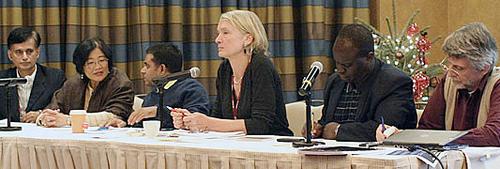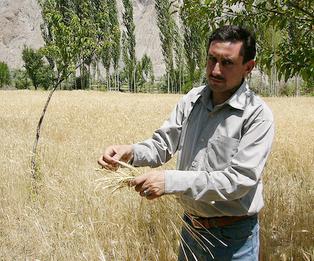Real Climate Change Costs Could Triple Early Estimates
LONDON, UK, August 27, 2009 (ENS) - United Nations climate change negotiations are based on "substantial" underestimates of what it will cost to adapt to global warming, scientists led by a former co-chair of the Intergovernmental Panel on Climate Change warned today.
The real costs of adaptation are likely to be two to three times greater than estimates for the year 2030 made by the UN Framework Convention on Climate Change in 2007, say Professor Martin Parry and colleagues in a new report published by the International Institute for Environment and Development and the Grantham Institute for Climate Change at Imperial College London.
Launched today at a news conference in London, the report finds that costs will be even greater when the full range of climate impacts on human activities is considered.
 |
Professor Martin Parry (Photo courtesy ICL) |
Parry and colleagues warn that this underestimate of the cost of adaptation could weaken the outcome of UNFCCC negotiations, which are due to culminate in Copenhagen in December with a global deal to limit greenhouse gas emissions that will take effect when the Kyoto Protocol expires at the end of 2012.
"The amount of money on the table at Copenhagen is one of the key factors that will determine whether we achieve a climate change agreement," says Parry, visiting research fellow at the Grantham Institute for Climate Change at Imperial College London. "But previous estimates of adaptation costs have substantially misjudged the scale of funds needed."
The UNFCCC has estimated the global costs of adapting to climate change to be US$40-170 billion each year.
But the report's authors say that these estimates were produced too quickly and did not include key sectors such as energy, manufacturing, retailing, mining, tourism and ecosystems. Other sectors that the UNFCCC did include were only partially covered.
"Just looking in depth at the sectors the UNFCCC did study, we estimate adaptation costs to be two to three times higher, and when you include the sectors the UNFCCC left out the true cost is probably much greater," warns Parry, who co-chaired the IPCC working group on impacts, vulnerability and adaptation between 2002 and 2008.
 |
Camilla Toulmin, center, addresses the High-Level Session on Funding Adaptation, organized by IIED, UN climate conference Poznan, Poland, December 2008. (Photo courtesy Earth Negotiations Bulletin) |
"Finance is the key that will unlock the negotiations in Copenhagen but if governments are working with the wrong numbers, we could end up with a false deal that fails to cover the costs of adaptation to climate change," says Camilla Toulmin, director of the International Institute for Environment and Development, which co-published the report.
Parry acknowledges that the 2007 UNFCCC study was a preliminary one of the funding, especially public funding, estimated to be needed in the year 2030 to meet the challenge of climate change. "It is not a study of the full cost of avoiding all damage," he wrote. "The authors suggest that their estimates are probably under-estimates and that much more study is needed."
The Parry report also evaluates estimates of the costs of adaptation made by preceding studies by the World Bank, 2006; by Sir Nicholas Stern, 2006; by Oxfam, 2007; and by the UN Development Program, 2007.
The Parry report's key findings include:
- Water: The UNFCCC estimate of US$11 billion excluded costs of
adapting to floods and assumes no costs for transferring water
within nations from areas of surplus to areas of deficit. The figure
does not include an allowance for costs of adapting in other aspects
of water resources management, such as managing increased flood
risk, maintaining water quality standards and supporting instream
economic and environmental uses. The underestimate could be
substantial, the new report states.
- Health: The UNFCCC estimate of US$5 billion excluded developed
nations, and assessed only malaria, diarrhea and malnutrition. This
could cover only 30-50 percent of the global total disease burden,
according to the new report.
- Infrastructure: The UNFCCC estimate of US$8-130 billion assumed
that low levels of investment in infrastructure will continue to
characterize development in Africa and other relatively poor parts
of the world. But the new report points out that such investment
must increase in order to reduce poverty and thus avoid continuing
high levels of vulnerability to climate change. It says the costs of
adapting this upgraded infrastructure to climate change could be
eight times more costly than the higher estimates predicted by the
UNFCCC.
- Coastal zones: The UNFCCC estimate of US$11 billion excluded
increased storm intensity and used low IPCC predictions of sea level
rise. Considering research on sea level rise published since the
2007 IPCC report, and including storms, the new report suggests
costs could be about three times greater than predicted.
- Ecosystems: The UNFCCC excluded from its estimates the costs of protecting ecosystems and the services they can provide for human society. The new report concludes that that this is an important source of under-estimation, which could cost over US$350 billion, including both protected and non-protected areas.
 |
This farmer in Chitral, Pakistan lost his wheat to water scarcity. July 2008. (Photo by Gul Hamaad Farooqi) |
It adds that the UNFCCC estimates do not include the cost of bearing 'residual damage' that will arise from situations where adaptation is not technically feasible or simply too expensive.
The report explains that in most cases, the UNFCCC estimation of funding needs was obtained by applying an increase in cost to those areas of investment deemed to be climate sensitive, the so-called "climate mark-up." In agriculture for example, two percent of investment on infrastructure is taken to be climate sensitive.
But, says the report, "applying a 'climate mark-up' is not appropriate when current investment flows are well below what they should be. In several parts of the world, current levels of investment are considered far from adequate, and lead to high current vulnerability to climate, including its variability and extremes," known as the "adaptation deficit."
Unless the adaptation deficit is "made good," the Parry report warns, "the enhanced investment for adaptation will not be sufficient to avoid serious damage from climate impacts."
The current adaptation deficit in agriculture is high, the report states. "The number of people at risk from hunger increased from around 300 million in 1990 to 700 million in 2007, and may exceed 1 billion in 2010 (FAO, 2009). A measure of the cost of making good this deficit is the cost of achieving the relevant Millennium Development Goal, estimated at $40–60 billion per year."
"Without this nonclimate investment," the Parry report states, "the estimated levels of investment for adaptation to climate change will be insufficient to avoid serious damage."
Professor Sir Brian Hoskins, director of the Grantham Institute for Climate Change at Imperial College London, which co-published the report, says, "The costs of adapting to live with a changing climate are very uncertain. However, this new report suggests that previous attempts to figure out the costs have drastically under-estimated how expensive this could be. With such large sums potentially involved, the pressure to act now to reduce the extent of climate change is greater than ever."
The new report was reviewed by seven of the world's foremost adaptation scientists, including the lead authors of the original UNFCCC study. Following this, close to 100 adaptation policy and research experts were invited to comment on the pre-publication draft.
The report's authors are: Professor Martin Parry (Imperial College London), Professors Nigel Arnell (University of Reading), Richard Tiffin (University of Reading) and Tim Wheeler (University of Reading), Dr Pam Berry (University of Oxford), Drs. David Dodman and David Satterthwaite (International Institute for Environment and Development), Dr. Sam Fankhauser (London School of Economics), Dr. Chris Hope (University of Cambridge), Dr. Sari Kovats (London School of Hygiene and Tropical Medicine), and Professor Robert Nicholls (University of Southampton).
Click here to read the report, "Assessing the costs of adaptation to climate change: A review of the UNFCCC and other recent estimates."
Copyright Environment News Service (ENS) 2009. All rights reserved.
To subscribe or visit go to: http://www.ens-newswire.com